This morning we woke up early and got our gear positioned in the two transition areas.
The Olympic distance for my race was a 1.5K swim, 40K bike and 10K bike. To put that in English units, it was about a mile swim, a 25 mile bike, and a 6+ mile run. Even though I have done a number of triathlons, this was my first Olympic distance race. So, I set my goal for the day to break 3 hours and if things went well to go under 2:45. Oh, and I didn’t train for the race at all. Anna and I ran a 10K race the weekend before, but that was all the athletic activity that I did for the 2 weeks leading up to the race. Not very smart, I know, but I’ve found it challenging to break away from my current job and hit the gym.
Anna, as part of the team, supported Mary and Lorena in their events but went all out for the bike course.
Here we are getting our gear setup:
The race started at 6:30 when it was light out, which was nice to be able to see, but made for a very hot finish.
The race started in the water, which was a good thing since it was VERY rocky. With all 150 or so people going out of the harbor mouth at the same time, it got a little tight. I can’t imagine doing a race with thousands of other people.
Here’s a shot of what the swim course looked like. It was beautiful water … crystal clear and fairly flat water. There were 3 divers that I saw underwater taking pictures. I smiled for them, but never saw the results. Oh well.
Here I am exiting the first transition area … off to go on a bike ride. After my 30 minute swim … I had a little trouble swimming in a straight line after the last buoy. Oops.
Mark right on my heels out of the water and on his bike.
Since Robbie had to do 2 laps (as opposed to our one lap) on the swim course, he was a little way behind, but going strong.
The bike course was quite simple … follow the main road around most of the island, turn around and come back. I felt pretty good on the bike and finished in about 1:13.
Here I am starting out on the run.
With Mark still on my heels…
The run course was simply beautiful. I’ve heard there’s an even better run course on Saipan, but I have yet to do the Xterra Triathlon there. Anyway, here’s a shot of the view from the run course.
So, about 8 kilometers into the run the heat became almost unbearable. Fortunately, there were people along the road with water hoses and drinking water. Without that, it would have been even worse … anyway, my run was by far the most challenging event. That was partly because it’s not normally tough, partly the heat and partly that I didn’t train. I finished the run in under an hour, but not by much.
My overall time for the race was 2:44. So, I beat my goal! Yea! I was pleased. Plus, I know I can do better next time.
As for placement, I finished 8th out of about 80 competitors and 1st in my age group.
Lorena, Anna and Mary combined for a 3rd place finish in the team event…and the only all girl team. Go girls!
Here I am very grateful to be finished.
Mary in the finishers tent.
After the race, we went back to the hotel to clean up, then out to get a little food. While we were doing that, Robbie was still out on the course. Just as we paid for our food, Robbie ran by on his last stretch.
We caught him at the finish line. He came across in 5:51. Quite a feat for his first Half-Ironman. That earned him 10th place in the Half-Ironman race. Good job Robbie.
That night we caught a ride from someone in the mayor’s office who was giving rides to athletes who didn’t have transportation to the race party.
Here we are enjoying some of the local drinks.
The mayor was quite a character and gave a very impassioned speech about the greatness of Rota. In fact the climax was:
“Rota is … beautiful!”
“Rota is … great!”
“Rota is … delicious!”
After the speech the 1st and 2nd place finishers from each age group were called up to receive their certificate and small prizes (I got a hat and inexpensive pair of sunglasses).
Here I am shaking the hand of the mayor.
The Guam Group.
That ended our race day. We then had the whole next day to explore the island. Our flight didn’t leave until the mid afternoon.
So, I will explain more in the next post…
–Jim
Category: Trips
Rota: Day 1
Last weekend was a first. It was the first time we had been to the small island of Rota and the first time we took our bikes on a plane.
First, since anywhere we go I like to find out as much as I can about the culture/people/geography/etc, here’s a little background.
Here are a couple of maps of the area for your reference:
Rota is one of 3 inhabited islands (there are 14 total islands) that make up the Commonwealth of Northern Marianas Islands (CNMI). Rota is the closest island to Guam at 40 nautical miles. Saipan (the largest island) is about 120 miles from Guam. In fact, on clear days you can see Rota from the northern side of Guam.
Here’s the flag of the CNMI:
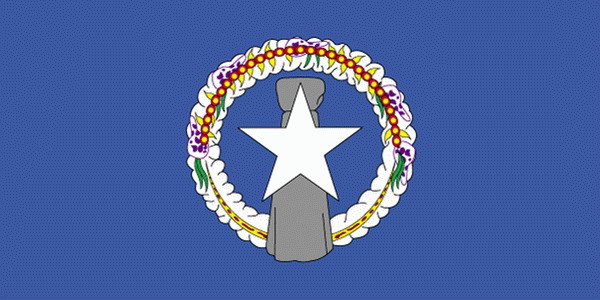
The latte stone in the middle is one of the significant cultural symbols for the Chamorro people indigenous to the region. It was used as a foundation for building structures. We visited a latte stone quarry later in the trip.
The people of Rota were very friendly. In fact, it had the feel of a small town in the US. Everyone waves at each other as they pass on the roads. There are less than 5,000 people living on the island and it’s about 32 square miles (about 10.5 miles long by 3 miles wide). For comparison, Guam is about 7 times larger with a population of 160,000. So, suffice it to say, Rota does not have the same infrastructure as it’s larger neighbor. However, we found it very endearing. There were 8 of us from Guam that went, so we had our own fun.
The economy of Rota is based on tourism (as is the rest of the CNMI and Guam). Agriculture is also important and the most significant products are sweet potato (a purple variety), breadfruit, coconut and cattle. That said, Rota and the rest of the CNMI benefit from a substantial infusion of money from the federal US government (on the order of hundreds of millions year).
The CNMI is a commonwealth in political union with the US. As such, it enjoys certain benefits, such as financial assistance and US citizenship for its local residents. However, since it is not a territory of the US, it is allowed more freedom to govern itself in areas like immigration, taxation (no federal income tax), and labor laws. Basically though, the government is modeled after the US.
We thought the pace of life was laid back in Guam…its hectic chaos compared to Rota though! There is very little to rush for….there is no movie theater, a handful of restaurants, and no fast food. There are plenty of beaches, crystal clear water, spectacular terrain, and perfect weather (most of the time).
So, with all that said, let me get on to the trip.
We took off Friday afternoon for the 15 minute flight up to Rota. We found out that even though a box for a bike is less than 50 pounds and slightly larger than a normal suitcase, it costs an extra $30 each way. Since we had 2 bikes, for the privilege of riding, Anna and I had to pay an extra $120. Oh well, just frustrating I suppose to pay for this “handling” that got us nothing special. I know, I sound bitter, but Continental has a stranglehold on the airline market out of Guam.
The eight of us were: Anna and me, Mark and Lorena, Mary, Dennis, Robbie and another Jim. Robbie was the only one brave enough to attempt the Half-Ironman distance. Mark, Jim and I each did the Olympic distance. The girls teamed up for the Olympic distance: Lorena swam, Anna biked and Mary ran. Dennis was our group photographer. 🙂
Here’s our first close look at the island.
You can see here just how clear the water was…
Mary proclaims, “We have arrived!”
Here’s our Guam contingent.
Welcome to Rota.
That evening, we went to sign up for the race, checked into the hotel, inspected our gear and prepped the bikes for the ride. We headed to bed pretty early to get a good night’s sleep….
Tomorrow will be the race.
–Jim
Palau — Above water adventure
After three full days of diving, we had to spend the last one above water…or at least not SCUBA diving, since we flew out that night. So, we decided that a tour of the islands from the perspective of a kayak was the way to go. We again went through the dive shop who supplied us with the boats, a guide and all the equipment we needed. 🙂
Here is the first of many secluded coves we stopped in:
Anna as a professional kayaker
As we paddled through the islands, we also stopped at historic sites. For example, we went to this Japanese pill box, which served as a machine gun nest guarding the passage. There was even an old helmet inside that’s presumably been there for 60 years.
Here we are, outside the bunker:
After inspecting the inside, we decided that the water looked very inviting from our vantage point, 40ish feet up the hill. So, I decided to get a closer look…
Once I found that it was indeed worth getting a better look at, Anna, jumped right in after me.
After a morning of paddling, we found a nice sheltered cave to have lunch in. We stayed in our boats for lunch though….there weren’t many places to sit in the cave.
Anna emerging from the darkness of the cave.
Yet again, I decided that high ledges and deep water are a good combination.
After our lunch break, we paddled over to a lake called Disney Lake. It’s so named for the array of colors in the underwater seascape. To get there though, the tide has to be low enough to open the passage way. We went through and there was about 2 feet of clearance…to pass through we laid back in the seat and pulled the boats through to the other side. Once there, we were treated to a very colorful snorkel spot.
Here are a few of the colors that make this Disney Lake:
We stopped by several other spots…for a little snorkeling, hiking and caving.
Here’s another stop we made:
Another cave to explore:
After we finished the official tour, our guide gave us the option of paddling all the way back to the shop. We decided that sounded like a pretty good plan, so off we went. About 2 hours later, we finally got back. It was a great workout and a great way to end the water portion of the trip.
That night we went out to eat and found another excellent restaurant (every place we went for dinner was really good). So, before we went in to eat, we watched the colors of a tropical sunset along the main thoroughfare of Palau. 🙂 A fitting end to the day and trip.
–Jim
Palau — Underwater adventures
Without a doubt, the biggest attraction in Palau is the SCUBA diving. The waters surrounding the islands are some of the most diverse (if not the most) in the world. There are over 700 species of coral and 1,500 animals. I’m sure we didn’t see them all, but so many that each time we went in the water, it was like a visual overload.
Each dive was unique….we did 7 dives and 6 snorkels over the 4 full days we were there.
Monday morning, we met up with Brian George (an Air Force friend from Guam) who was in Palau for work. Rough job, huh? We got our gear set up and jumped on a small boat for the hour plus ride out to the dive sites.
Here’s a picture of the harbor at Sam’s Tours (our dive company):
Our first destination was Turtle Cove. It was a great site to start with. Tons of creatures, great visibility and a neat little cave to start off in.
The pictures I have of this dive are on a film camera, and the results leave something to be desired. I really wish I had a quality underwater digital camera.
This is a friend who decided to swim right up to me…It was early in the dive and I was fascinated by him. He shared my curiosity and swam right at me, only to turn away about 3 feet from my camera.
Not to worry though, it was relatively small (about 7 feet) and only a reef shark.
We also saw a number of turtles (which Anna loves).
With the thousands of fish we also saw, it was a great dive.
For lunch we stopped by a small island to have a picnic lunch (they are much more amenable to picnics than the Japanese were).
The afternoon, we went to German Channel. So named because while Germany controlled the islands from 1899-1917, they blasted a passage through the coral to facilitate boat traffic. It boasts a number of wrasse cleaning stations (where the big animals like sharks and manta rays come to get cleaned by the aptly named cleaner wrasse). We were fortunate and saw sharks, a 10 foot manta ray and a plethora of other fish….the only downside was that the visibility wasn’t as good as other locations. This suits the plankton eating manta just fine and is a big reason why we saw one.
Here’s a picture of the manta:
Tuesday began similar and while Brian wasn’t able to join us (he had to fly out that night), we were joined by Kevin Davidson. He’s a professional photographer/videographer that works in conjunction with the dive shop. He agreed (for a small price of course), to follow us around and video our dives on Tuesday and photograph on Wednesday. His work is simply amazing and gave us a very professional product.
If you’d like to see the video of Tuesday’s dives, you’ll have to come visit though….
Our first dive of the day was the signature dive in Palau: Blue Corner. This is where strong ocean currents bring almost every imaginable aquatic life together. Crystal clear water provides a great medium for watching the show.
There are many sharks, and large schools of fish. The strong current requires that divers use a hook to hold themselves in place. In fact it’s strong enough to rip off a mask or regulator, so caution is certainly needed. 🙂 We also watched a huge school of jacks (from the barracuda family) swim in place. You would recognize these fish as the speaking school of fish that gives directions in “Finding Nemo.”
Next was lunch on the boat and a little siesta in a protected bay.
The dive after lunch was back to German Channel. Each boat had no more than 8 divers, but since they try to accommodate everyone, we ended up going to German Channel 3 times. Each time you dive a site though, you never know what you are going to see….so, we didn’t mind the repetition. This time we saw yet another Manta (this one was almost an albino).
Wednesday was our photography day, so now we have more photo-documentation to accompany my descriptions.
The first dive of the day, was reputedly the best wall dive in the world. It’s simply named, “Big Drop.” It goes from knee deep water to over 900 feet in a vertical drop. The attraction is both the underwater architecture, but perhaps more importantly the plant and animal life. It made a nice fore/background to the pictures Kevin was taking for us.
In fact, here are some:
Anna and I enjoying a moment together…. 🙂
Here’s a self-portrait of Kevin….
Once we finished our dive at the wall, we headed back to the same island we went on the first day for another picnic lunch.
Here’s Anna enjoying her lunch in a tropical paradise:
Here are the boats we took for the day (that’s Kevin taking a nap in the back….we must have tired him out with the first dive):
Our second dive was…surprise, surprise, the German Channel. However, here’s how the boat captain got us there (safely, I might add…)
Our lunch site again:
Once we got back to the channel, we all jumped in for another awe inspiring dive…
Here’s my favorite sea creature, the massive manta ray:
The sandy flat bottom of the channel makes a great home to colonies of garden eels. They come out and wave in the current like grass, but quickly go back into their holes at the first sign of danger. Very cute.
Another very unique creature we saw a lot of were giant clam. These got as large as 5 feet across. Don’t worry, the lore that they will snap closed on a divers foot is only a myth…they feed on much smaller animals like plankton.
The third dive for the day was back by the dive shop. It was perhaps the best dive of the whole trip. It’s called Chandelier Cave. It has 4 main chambers. Each one has an air pocket at the top (we surfaced in each) and is a series of interconnected caves. In 2 of the chambers, I was able to get out of the water and explore the land cave. The water was beautiful and once we were in the cave itself the visibility was perfect. It was quite a site. Unfortunately, Kevin didn’t go with us and my batteries ran out in my camera. 🙁 However, I did get one shot of Anna as we surfaced inside the first chamber:
Here’s a shot from the web that someone else took. It gives an idea at least of what the cave looks like underwater.
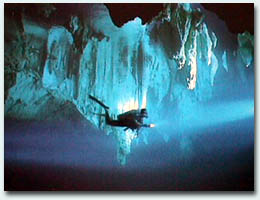
That finished our diving experiences. It was without a doubt the best diving we’ve ever done (better even than the Great Barrier Reef in Australia).
The next post will cover our last day and the adventure we had above the water. 🙂
–Jim
Underwater Wonder of the World — Palau
Since Anna and I moved to Guam last year, we have become better acquainted with the underwater world.
This past week, we had the opportunity of a lifetime to travel to and SCUBA dive in the #1 Underwater Wonder of the World that is the Republic of Palau (at least as ranked by the Smithsonian).
Wow.
Ok, That about sums up the trip. No need to say anything else.
Alright, I will say a little more. If you are curious what the other wonders of the underwater world are though, here they are:
1. Palau
2. The Belize Barrier Reef
3. The Galapagos Islands
4. The Northern Red Sea
5. Lake Baikal
6. The Great Barrier Reef
7. The Deep Sea Vents
First, what is Palau? Good questions….it’s a small island nation in the southwest Pacific. In relation to Guam, it’s about 1000 miles to the southwest. Guam is 13 degrees north and Palau is 7 degrees north. So, as you can imagine the climate is rather similar. Although, we noticed less humidity, compared to Guam.
Palau has a similar history to most islands in the western Pacific. It was occupied by the Japanese in WWII, and liberated by the Allies. After the war, it joined the Trust Territory of Pacific Islands administered by the US. However, instead of eventually joining the Federated States of Micronesia, Palau chose to remain independent. In 1994, it was admitted to the UN, after signing the Palau Compact with the US (after a decade of debate). The compact assured virtual independence with the US providing economic aid and defense for the 20,000 inhabitants. Ironically, the issue that held up the approval was Palau’s desire to be the first nuclear weapon free state (including those carried on US warships/aircraft). That issue resolved, the main struggle now (as with many small islands) is developing a sustainable economy and infrastructure. While there is much to improve on, Palau has realized protection of their splendid natural resource is paramount to their future. As such, the people and government work to develop a compromise in harvest and protection of the underwater bounty surrounding the islands.
It’s interesting to note that there are more than 300 islands in Palau, only 17 nations have a smaller population. Palauans are a proud people with a proud history. It was fascinating interacting with them and viewing their world.
Before I get into our trip though, I will include some pictures taken by a photographer we met in Palau, and American named Kevin Davidson. He also took some video and photographs of us, but that’s the next story. So, while not taken by us (or even while we were there), they do a great job giving a glimpse at the beauty of the archipelago of Palau.
Here is an aerial view of one of the many islands….
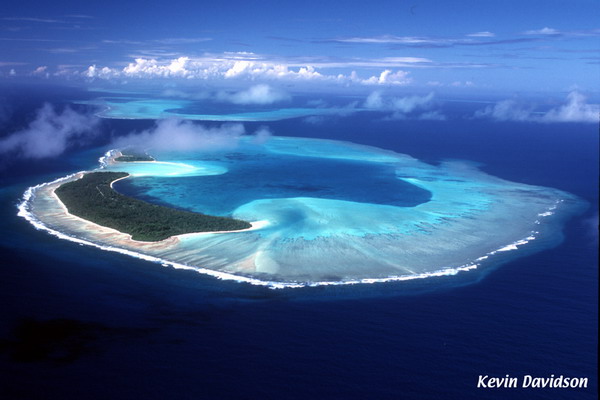
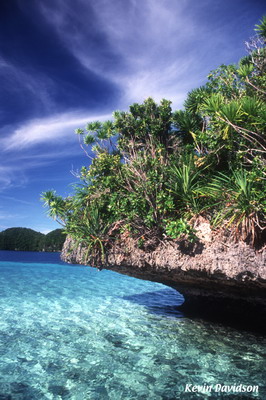
Some of the underwater inhabitants around the islands:
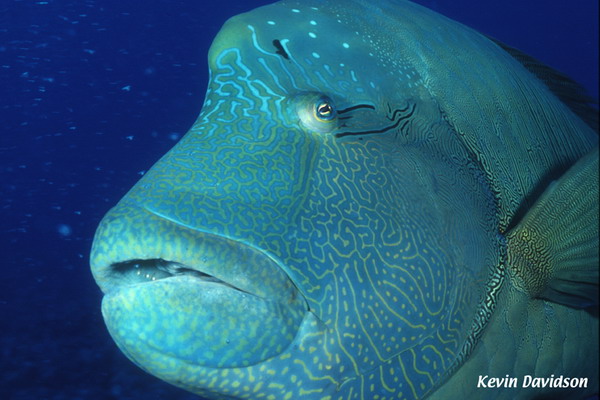
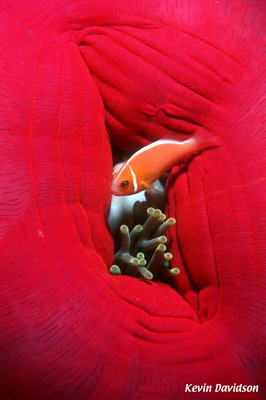
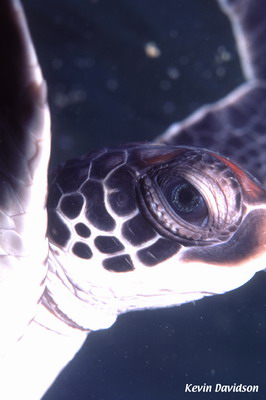
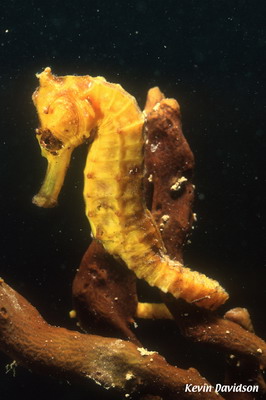
Yes, we saw plenty of his brethren.
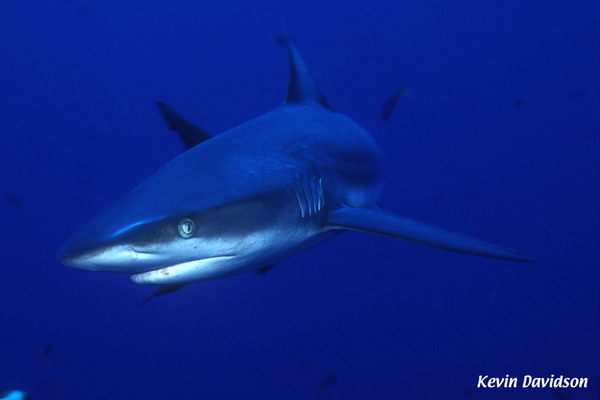
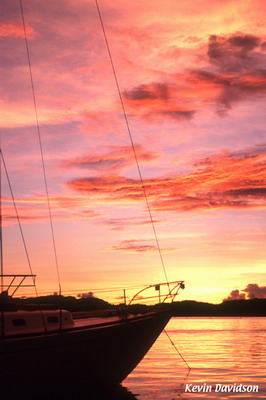
Ok, hopefully that whets your appetite, as the next post will detail our trip to Palau.
Until then.
–Jim
Japan Trip — Part 4 (last one)
This is the fourth and final entry from our trip to Tokyo last month.
After our return from Mt. Fuji, we rested up during the day and went back out that night. We decided that we wanted to see a traditional Japanese Kabuki theater show. However, since we don’t speak Japanese, we opted for a tour package that included an English speaking guide and headsets that provided the English translation.
Here’s a picture of the Kabuki-Za Theater we went to.
We enjoyed the show, but it seemed that the acting was more based on physical acting than delivery. It’s a style of theater that takes some getting used to.
We also decided to visit the Imperial Palace and gardens surrounding it. Here’s where the Emperor of Japan lives…
Here are his gardens:
Here’s a great view of the juxtaposition of the serene and chaos apparent all over Tokyo.
That ends our trip to Japan. We loved it and look forward to going back. When we do visit again, we already have a list of places we want to see. So, until then….
-Jim
Japan Trip Part 3– Mt Fuji
Hi, this is the third chapter of our Japan trip in July. It’s by far the longest and if it has taken a while to load, I apologize.
A little background before the pictures….
One of most important reasons we chose to visit Tokyo was to climb Mt. Fuji.
As the tallest mountain in Japan and spiritual appeal to locals, Fuji-san is certainly the most revered mountain in Japan. It’s said that a wise man climbs Fuji-san once, but a fool climbs it twice.
We certainly enjoyed our climb, and the following is a brief synopsis highlighted with our photos.
Fuji-san is a freestanding volcano (similar to Mt Kilimanjaro in Africa) with the summit 12,388 ft above sea level. The mountain is divided into 10 stations. The most popular place to begin (and where we started) is from the 5th station at about 7,000 ft.
Since we climbed right in the middle of the “official” climbing season, we expected large numbers of people to join us on the trek to the summit. While we never had to wait in line to continue the hike, we did meet lots of interesting people. Almost from the very beginning, we met 2 other young American couples climbing. They lived in Tokyo and worked at Tokyo Disney (sound familiar, Rob??). We all got along well, and basically ended up climbing the entire mountain together.
Since large crowds were expected, we decided to climb through the night to arrive at the summit around sunrise. So, we left our hotel at about 8 PM to catch a bus that would take us to the fifth station.
We actually began hiking at about 11:30 PM. The sunrise was at 4:40 AM, so that gave us about 5 hours to reach the summit in time. Unfortunately, we didn’t quite make it up to the very top, but we stopped at the station right below the crater rim to enjoy one of the most spectacular sunrises ever.
Truly, the sunrise from the top a mountain is breath taking and one from a “free-standing” mountain is unbelievable. I’ll let you decide for yourself though….
Here’s Anna right before the sun peeked out from under the clouds.
One downside to the top of the mountain is that it was VERY windy (notice my hood is about to fly away…) As we got closer to the top, the wind became almost unbearable. It even made the wind in Colorado seem gentle in comparison. The worst part was that the wind carried the fine, gritty volcanic dust and it was impossible to protect your eyes from it. If you ever climb Mt. Fuji yourself, remember your ski goggles….they would have been HUGELY beneficial.
Here we are enjoying a hot cup of cocoa trying to avoid the wind/dust. This is the inside of the 9th station. We rested here for a little while before the final push to the top.
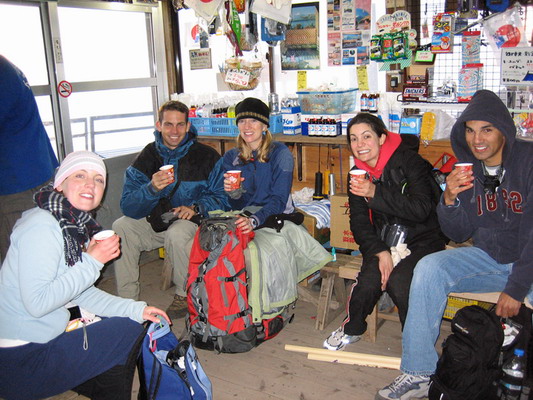
Once we’d thoroughly warmed up and were ready to brave the wind again, we headed back out for the final ascent. It was even worse than before. At times the wind was so strong, I could not stand in place. I estimate that the wind gusts were over 80 MPH. If the trail had been treacherous, I would have turned our group around, but it was just safe enough to continue. We eventually made it to the top and here’s what the top of a volcano that last erupted in 1707 looks like:
There are even enough visitors to the top to support a mall of sorts. It was still closed when we arrived, but interesting to see nonetheless.
A view from the top of Japan…
Looking back down at station 9:
This is as close to snow as we’ve been in the last year:
Well, after hours of slogging up the mountain, we finally got to come back down. Here the soft soil made it very easy to move quickly with very low impact. 🙂 Unfortunately, that meant we got even dirtier than before! Here’s proof:
We were excited to be done though.
Fuji-san graced us with a brief appearance from behind the haze and clouds and allowed a view to where we had been.
Here’s what most people did after climbing 🙂 Pass out in the middle of the plaza.
Japan Trip Part 2
OK, so I have been quite remiss in my publishing of these pictures. Thanks to everyone who asked for them. Here is the rest of our trip to Tokyo in July.
Anna enjoying a pastry snack…
Downtown at night…
This is the prefecture we stayed in.
Roppongi really comes alive at night. It’s the epicenter for westerners at night.
We visited several parks while in Tokyo. There are a couple unusual things we noticed.
1. People do not eat lunch in the park. We tried once and found we were the only ones, even though there were hundreds of other people there at lunch time. Most people were just there to be outside. When we walked away though, there were numerous cars parked along the edge of the park. People chose to sit in their cars (with the A/C running) and eat their lunch.
2. There is a very small (visible) homeless population in Tokyo or the surrounding prefectures. However, in this park, we found a group of blue tarps and tents. They looked semi-permanent. From what we understand, this is a tolerated compromise to a small problem in a country where space is at a premium. Here’s what they look like:
More pictures of the park and museums:
Here are a few shots of a shrine. There are many shrines of varying intricacy. Fascinating to look through, even if you have no idea what the writing says….
Another highlight of our time in Tokyo was the shopping experience, and experience it is. This is a typical street side market. Notice the train line overhead. The public transportation is the best we’ve ever seen. Fast, affordable, ubiquitous and best of all….always on time. 🙂
I’ll finish this installment of the trip here. There will be a third chapter soon though….. 🙂
–Jim
Japan Trip Part 1
It has now been a week since we returned from a week in Japan. We spent most of our time in Tokyo, with a few trips to the surrounding area. If we had more time, we’d love to go back and explore Kyoto for a couple days at least.
Ok, enough with the intro, here is our trip as captured in photographs…
First, we stayed in the Roppongi district, so the first order of business was a walk about to get a feel for the city and more importantly, see what was around.
Here is a picture of a cemetery (along with a number of prayer sticks) in the middle of the city. We liked the contrast here.
This is me, walking the streets…
A bike that Anna liked…
Fireworks were invented in China and since Japan has the benefit of proximity, we decided that the display being advertised was worth a trip to the adjacent city of Yokohama. It turns out that most people in Tokyo decided to join us there….well, at least it seemed that way. The train system was completely flooded with people. However, the Japanese government it their usual efficiency were able to get everyone into a very small space with relatively little problem. In fact, it was amazing to watch 50,000+ people move into a few small block, occupy less than 6 square feet each and not complain at all! We Americans could learn a few lessons from them! Anyway, the firework display was worth the effort. The following pictures don’t do them justice, but there were over 8,000 individual fireworks that lasted over an hour. If only we had brought our Crazy Creek chairs (backpacking chairs for the ground), we would have been all set. Unfortunately, the asphalt of the street intersection where we were sitting got a little uncomfortable after the first 45 min or so…. 🙂
Here’s an unfortunately blurry shot of our fellow firework watchers.
Anna ready to be amazed by the fireworks.
The highlight of the firework display were the “shaped” fireworks. There was even a “Hello Kitty” firework!
Here they are:
Suffice it to say, that we were quite impressed. This was all just to celebrate a Japanese national holiday known as Marine Day. It was free to watch and worth every penny.
Silver Flag
Civil Engineers in the Air Force have an interesting job. During peacetime (at home station), they are responsible for maintaining the infrastructure and new construction (among other things). During wartime though, the mission is entirely different. It’s to bed down forces in a new (possibly austere) location and set up the base for air operations.
Since that wartime mission is so different from the peacetime one, we go out to a remote site and train just for that mission. In our case at Andersen AFB, we went to Okinawa, Japan for about a week to train.
This was the plane we flew over to Japan in. The kids loved it….
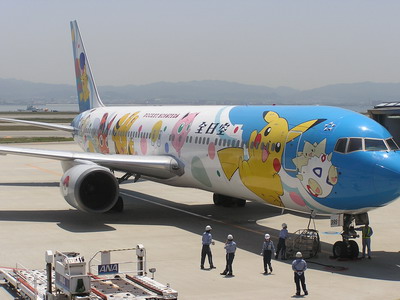
Once we got to the site, we set up camp:
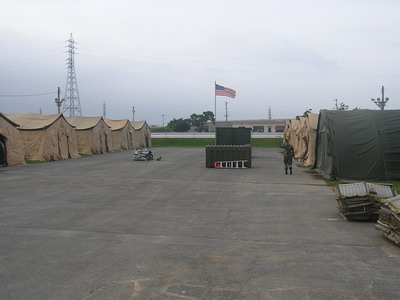
And began the specialized training. Everyone there had a particular job to do. For me, that was Command and Control (directing information from and to the field).
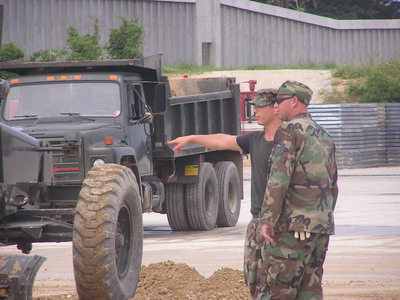
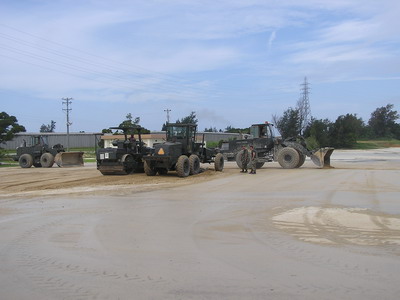
For everyone who’d ever wondered, here’s what a latrine for the field looks like. Nice, huh?
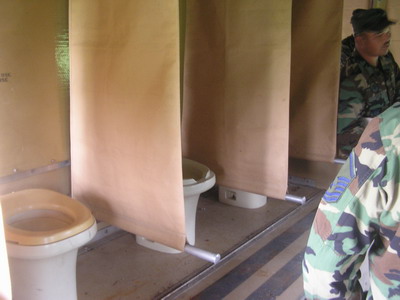
As a side trip, we went to some tunnels that had been built by the Japanese military in WWII. Rather extensive network.
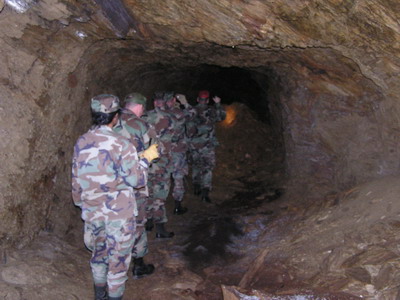
Inside we found the most unusual creatures:
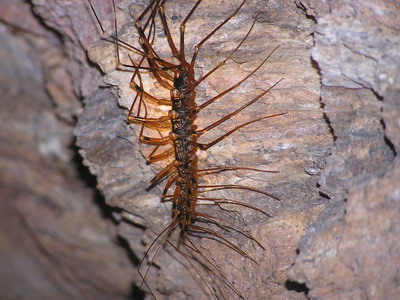
We also visited one of the shrines at Kadena AB.
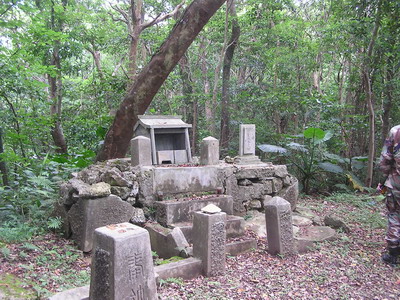
And found a guardian vigilantly watching over it:
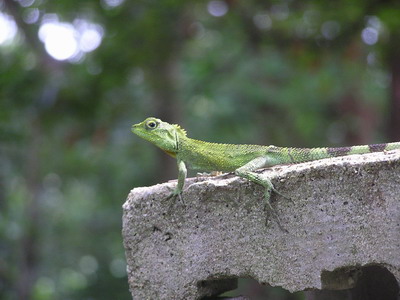
After a week of intense training, it’s nice to return to the comfort of home. It’s not a “true” deployment out to Afghanistan or Iraq, but it’s certainly good preparation if I do have to go again.
Jim
